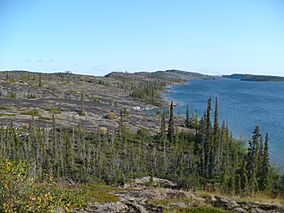Thaidene Nëné National Park Reserve facts for kids
Quick facts for kids Thaidene Nene National Park Reserve |
|
|---|---|

Utsingi Point
|
|
| Lua error in Module:Location_map at line 420: attempt to index field 'wikibase' (a nil value). | |
| Location | North Slave Region Northwest Territories Canada |
| Nearest city | Yellowknife |
| Area | 14,070 km2 (5,400 sq mi) |
| Established | 21 August 2019 |
| Governing body | Parks Canada |
Thaidene Nene National Park Reserve is a special place in Canada. Its name comes from the Dene language and means land of our ancestors. This national park is found near the eastern part of Great Slave Lake in the Northwest Territories. It sits at the northern edge of Canada's huge boreal forest.
Parks Canada helps manage this park. It is also part of a bigger area called the Thaidene Nëné Indigenous Protected Area. This larger area includes other protected lands looked after by the Government of the Northwest Territories. The National Park Reserve itself covers about 14,070 square kilometers. This huge area protects important forests, open tundra, and freshwater lakes and rivers.
Amazing Animals and Nature
Thaidene Nene National Park Reserve is home to many different animals. It helps protect caribou and other furry creatures. You might see animals like lynx, wolves, red foxes, wolverines, martens, moose, and black bears.
Other mammals living here include Arctic foxes, beavers, muskoxen, and grizzly bears. You can also find barren-ground caribou roaming the land.
The park's landscape is truly beautiful. It has tall red granite cliffs. You'll also find many amazing peninsulas, deep canyons, and rushing waterfalls. As you travel north, the dense forests slowly change into the wide-open northern tundra. Many different kinds of migratory birds also visit this area. They use it to rest and build their nests. These include various types of ducks and songbirds.
How Thaidene Nene Was Created
The idea for a national park in this area started a long time ago. In 1970, plans for a park were put aside. But in 2001, the Łutsël K'é Dene First Nation brought the idea back. They wanted to protect their traditional lands.
From 2002 to 2004, people talked about if a park was possible. The Métis Nation also joined these discussions. By 2005, the Łutselk'e Dene First Nation officially supported the idea. They wanted a national park as part of a bigger plan to protect their territory. They worked with other Akaitcho First Nations.
In 2006, the Łutselk'e Dene First Nation and the Minister in charge of Parks Canada signed an agreement. This agreement made the area being considered for the park much larger. It also set out how they would work together to create the national park. The park was first expected to be ready by 2009. However, talks continued for many years.
By 2014, the government of the Northwest Territories took over managing the park study area. The next year, they started a new plan. This plan included a slightly smaller National Park Reserve of about 14,000 square kilometers. It also added other protected areas managed by the territory. This way, 75 percent of the original study area would be protected. People shared their thoughts on these new boundaries in 2016. The Canadian government also set aside money in its 2016 budget to help make Thaidene Nene a reality.
On June 10, 2015, Parks Canada and the Northwest Territory Métis Nation reached an important agreement. This agreement covered most parts of how the park would benefit everyone. Both groups still needed to review and approve it.
The Government of Canada announced its suggested boundary for the park on July 29, 2015. They then started official discussions about these boundaries.
Finally, on February 15, 2019, the Łutselk'e Dene First Nation voted to approve the park's creation. On August 21, 2019, a big agreement was signed. This agreement was between Parks Canada, the Government of the Northwest Territories, and three First Nations. These were the Lutsel K’e Dene First Nation, Deninu K'ue First Nation, and Yellowknives Dene First Nation. This agreement officially created the protected area. It includes a 14,305 square kilometer national park managed by Parks Canada. It also has a 12,220 square kilometer area managed by the territorial government, which includes a wildlife conservation area.

